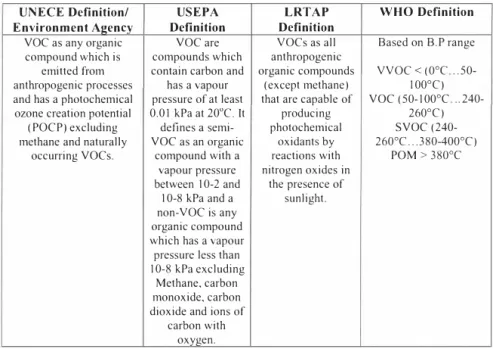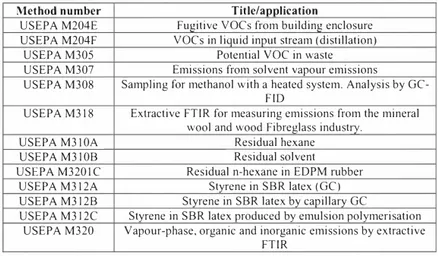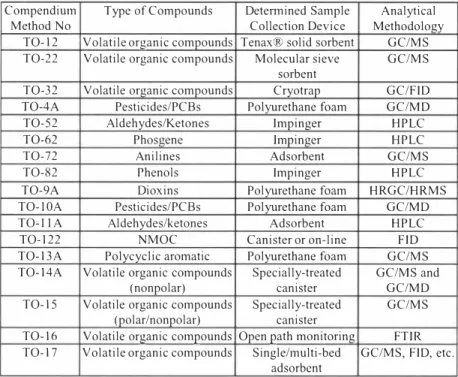Kalmar ECO-TECH '07 KALMAR, SWEDEN, November 26-28, 2007
ISSUES IN
voe
MONITORING AND
REPORTING
Anjali Srivastava
National Environmental Engineering Research Institute, Kolkata, India
ABSTRACTVolatile Organic Compounds (VOCs) present a particularly unique testing dilemma since there are a large number of different compounds defined as VOCs, The process of accurately and consistently measuring the quantity of total VOCs emitted is a matter of concern to policy makers and researchers,
Each method has advantages and disadvantages relative to the other methods, The choice of measurement and reporting techniques depends on the purpose that the data will serve, Due to differing analytical limitations for each of the VOC test methods, all sources may not be able to use the same method/ procedures to monitor and report,
Because of the wide variety of compounds of interest coupled with the lack of standardized sampling and analysis procedures, detennination of pollutants in ambient air is a complex task, Many toxic organics can be sampled and analyzed by several techniques, with different interferences and detection limitations, No uniforn1 averaging period is defined for ambient voe measurement,
I INTRODUCTION
Volatile Organic Compounds (VOCs) are major class of pollutants causing concern, VOCs are part of the large hydrocarbon family, a vast array of aliphatic, aromatic hydrocarbons, their halogenated derivatives, alcohols, ketones and aldehydes, VOCs have a property of conversion into vapour or gas without any chemical change, They are highly reactive hydrocarbons and participate in atmospheric photochemical reactions, Some of them have negligible photochemical activity; however they play an important role as heat trapping gases in atmosphere,
Sources: Many VOCs are of natural origin while many owe their existence to anthropogenic activities, Natural sources of VOCs include forests, tem1ites, oceans, wetlands, Tundras and volcanoes, Estimated global emission rate of biogenic VOCs is 1150 Tgyr-1 (Guenther et al,J 995)
The anthropogenic sources of VOCs consist of vehicular emissions, petroleum products, chemicals, manufacturing industries, painting operations, varnishes, coating operations, consumer products, petroleum handling, auto refinishing, cold clean degreasing, printing inks, dry-cleaning etc,
In presence of oxides of nitrogen and sunlight, VOCs fom1 ozone and other products, Oxidation of VOCs by reaction with hydroxyl radicals is the main removal process, The oxidation of complex organic molecules leads to the fragmentation, production of a range of reactive free radicals and more stable smaller molecules such as aldehydes, VOCs are cause of concern firstly due to its role in formation of ground level ozone and smog and secondly due to some of them being carcinogenic, mutagenic and teratogenic in nature, Adverse effects
Kalmar ECO-TECH '07 KALMAR, SWEDEN, November 26-28, 2007
of ozone on human health, crop viability and yields are well documented. Wide range of voes, imply wide range of reaction rates, which means large range of transport distances. Many VOCs have low reactivity and thus long atmospheric life times and can be classified as Persistent Organic Pollutants (POPs). Some VOCs are Hazardous Air Pollutants (HAPs) by virtue of their toxicity.
International concerns regarding voes arise due to their ability of long range transport, distribution and accumulation in various components of environment, their toxic nature and significant contribution from natural sources.
I.I Definitions of VOCs
Definitions of voes vary according to context. A general definition is "VOCs are organic substances which are volatile and are photochemically reactive". Table I summarizes the definitions of voes used by various organizations.
Table 1. Definitions of VOCs.
UNECE Definition/ USEPA LRTAP WHO Definition
Environment Agency Definition Definition
voe as any organic voe are VOCs as all Based on B.P range compound which is compounds which anthropogenic
emitted from contain carbon and organic compounds VVOC <(0 e ° .. 50-anthropogenic processes has a vapour ( except methane) 100°C) and has a photochemical pressure of at least that are capable of voe (50-I00 e ° ..
240-ozone creation potential (POCP) excluding methane and naturally
occurring voes.
0.0 I kPa al 20°C. II producing 260°e) defines a semi- photochemical svoe (240-voe as an organic oxidants by 260°C,, .380-400 () °
compound with a reactions with POM > 380 e ° vapour pressure nitrogen oxides in
between I 0-2 and the presence of I 0-8 kPa and a sunlight. non-VOe is any
organic compound which has a vapour pressure less than I 0-8 kPa excluding
Methane, carbon monoxide, carbon dioxide and ions of
carbon with oxygen. 1.2. Challenges in monitoring VOCs
Volatile Organic Compounds (VOCs) present a particularly unique testing dilemma since there are a large number of different compounds defined as voes. The process of accurately and consistently measuring the quantity of total voes emitted is a concern to industry, researchers and regulatory agencies. Measurement of voes can be divided into two categories:
Kalmar ECO-TECH '07 KALMAR, SWEDEN, November 26-28, 2007
--, Source En1issions ► Ambeint Air
1.3. Source emission monitoring
There are three primary mechanisms for evaluating voe emissions. ',- Material Balance
► Emission Factors ► En,ission Testing
All of above can be used for source emissions and reporting fonnat depends on the compliance requirement. Any technique of measuring voes must consist of three major components namely,
*
the means of detection of the target analytes;*
the means of extraction, and*
the sampling and transport mediaUSEPA has promulgated number of methods for voe measurement. Table 2. Key promulgated USEPA methods.for VOC monitoring.
Method number Title/annlication
USEPA Ml8 VOCs by GC analysis, sampling and on-line systems USEPA M2I VOC leaks (fugitive emissions).
USEPA M25a Gaseous VOC concentration by Flame Ionisation Detector USEPA M25b Gaseous VOC concentration by infrared analyser USEPA M25c Non-methane organic carbon in landfill gases USEPA M25d VOC of waste samples
USEPA M25e Vapour Phase organic concentration in waste samples OSW MOOIO Semi VOCs by GC after sampling with a modified Method 5
(MM5) train
OSW MOO! I Aldehydes by sampling with a MM5 train and 2,4-DNPH. Analysis by GC-M5 or HPLCUV
OSW M0030. Sampling with a 2-tube VOST and analysis by GC. For medium volatility VOCs
OSW M003I Sampling with a 3-tube VOST. and analysis by GC. For medium to very high volatility organic compounds. OSW M0040 Bag sampling for high volatility, high concentration
compounds.
USEPA MI06 Determination ofaVCM (Vinyl Chloride Monomer) USEPA M107 VCM of in-process waste water samples
USEPA MI07a VCM of solvents
USEPA M204A VOCs in liquid input stream
USEPA M204B VOCs in captured stream
USEPA M204C VOCs in captured stream (dilution technique) USEPA M204D Fugitive VOCs from temporary total enclosure
Kalmar ECO-TECH '07 KALMAR, SWEDEN, November 26-28, 2007
Table 2. Key promulgated USEPA methods for VOC monitoring (Continued).
Method number Title/application
USEPA M204E Fugitive voes from building enclosure USEPA M204F voes in liquid input stream (distillation)
USEPA M305 Potential VOe in waste
USEPA M307 Emissions from solvent vapour emissions USEPA M308 Sampling for methanol with a heated system. Analysis by
Ge-FID
USEPA M3l8 Extractive FTIR for measuring emissions from the mineral wool and wood Fibreglass industry.
USEPA M310A Residual hexane
USEPA M3l0B Residual solvent
USEPA M320le Residual n-hexane in EDPM rubber USEPA M3l2A Styrene in SBR latex (Ge) USEPA M3l2B Styrene in SBR latex by capillary Ge
USEPA M3l2e Styrene in SBR latex produced by emulsion polymerisation USEPA M320 Vapour-phase, organic and inorganic emissions by extractive
FTIR
The correct determination of VOC emission rates is dependant on multiple factors. One factor is the ultimate purpose of the data. If testing is perfonned for regulatory purposes, then the regulating agency must define the pollutant and the reporting units. Usually regulating agencies require knowing total VOC emission, control efficiency of control equipments and concentration limits. Commonly used methods are M 18, M25 and M25A. These methods suffer from limitations of detection technology and accept M 18 other report TVOC as "Carbon" or "Methane". M 18 uses FID & MS as a detector. M 18 is excellent for speciating individual compounds, testing for Toxic Air Pollutants (T APs) and Hazardous Air Pollutants (HAPs), for mass emission tests when there are only a few VOCs in the gas stream, and for characterizing a gas stream. Method I 8 utilizes gas chromatography to separate the VOC compounds from each other and from other interferences in the gaseous stream. The detector used in this method is specifically calibrated for each VOC compound present using known standards to develop response factors and linear operating ranges for the method. This method is capable of providing true results in terms of individual VOC components which when totaled provide a total VOC concentration. The main advantage of this method is that results are reported "as VOC".
Method 25 measures TGNMO (total gaseous non-methane organic) by first separating the VOC components from methane, carbon monoxide and carbon dioxide. The remaining VOC compounds are chemically converted to methane molecules, which are quantitatively measured by a FID (flame ionization detector). This method provides a measurement of the VOC composition in tem1s of its carbon content. This method nom1alizes the response factor for individual VOC components since the carbon in each component is converted to methane before performing the quantification. This method has detection limit of about 50 ppm carbon cannot be used on many outlets where the concentration is often considerably less than that. This method reports VOC "as Carbon".
This procedure involves two errors: response factors and total VOC molecular weight. For eg without an average MW, the data is often reported on a mass basis 'as carbon' or in tem1s of another surrogate.
Kalmar ECO-TECH ·07 KALMAR, SWEDEN, November 26-28, 2007 gms/hr (as Carbon)= K *ppm * 12.0 I *Flow rate
gms/hr (as VOC) = K *ppm *Flow rate*(MW VOCI no.C)
Method 25A is an instrumental method in which the VOC is introduced into a FID chamber without first separating the VOC components. The FID is calibrated with a standard gas such as methane or propane and the method results are often reported in tem1s of the calibration gas used (e.g., "as propane"). The main problem with this method is the variation of the FID response to VOC components other than hydrocarbon compounds. VOC compounds containing oxygen or halogen atoms may differ as much as two-fold in FID response from similar hydrocarbon compounds. This method is sensitive to low concentrations, relatively easy to use, low cost and may be converted to "as VOC" results for simple gas streams where the composition is known.
1.4 Ambient Air Monitoring
Measurement of VOCs in ambient air is often difficult, because of the variety of VOCs of potential concern, the variety of potential techniques for sampling and analysis, and the lack of standardized and documented methods. Measuring TVOC concentrations does not provide reliable indication of potential health impacts of air pollution. In case of ambient air monitoring of VOC is aimed to control /avoid adverse impacts on humans and ecology must result in knowledge of
• Types of VOCs • Concentrations of VOCs • Their dispersion routes
• Their fate in environment
• Category of VOCs in tenns of photochemical ozone creating potential VOCs that are of important due to their toxicity are listed in Table 3.
Kalmar ECO-TECH '07 KALMAR, SWEDEN, November 26-28, 2007
Table 3, List of VOCs Identified to be of Importance due to their Toxicity,
Compound Category
acrylamide cat.2 carcinogen and mutagen acrylonitrile cat.2 carcinogen
azinphos-methyl very toxic
benzene cat. I carcinogen
benzo(a)anthracene cat.2 carcinogen
benzo(b )tluoranthene cat.2 carcinogen
benzo(k)tluoranthene cat.2 carcinogen benzo(j) fl uoranthene cat.2 carcinogen
benzo(a )ovrene cat,2 carcinogen, mutagen and teratogen
butadiene cat.2 carcinogen
carbon disulphide cat.2 teratogen 1-chloro-2,3-epoxyprooane cat.2 carcinogen chloroethene (vinyl chloride) cat. I carcinogen dibenzo(a,h)anthracene cat.2 carcinogen 1,2-dichlorethane cat.2 carcinogen
dichlorvos very toxic
dieldrin very toxic
diethyl sulphate cat.2 carcinogen and mutagen
dimethyl sulphate cat.2 carcinogen
dnoseb cat.2 teratogen
endosulfan very toxic
endrin very toxic
1,2-epox ypropane cat.2 carcinogen
2-ethoxyethanol cat.2 teratogen
2-ethoxyethyl acetate cat.2 teratogen 4,4' -methylenebis(2-chloroanaline) cat.2 carcinogen 4,4' -methylenediphenyl diisocyanate very toxic (inhalation)
nitrobenzene very toxic
2-nitropropane cat.2 carcinogen
phenol very toxic (inhalation)
phorate very toxic
phosgene very toxic
oolychlorinated biohenyls !ARC grouo 2A 2-oropen- 1-ol very toxic (inhalation)
oyrene very toxic
I, 1,2,2-tetrachloroethane very toxic
Very little guidance is available for the detem1ination of toxic organic compounds in ambient air, As a result, while monitoring voes as air pollutant one is required to develop his own monitoring strategies, including selection of monitoring methods, sampling plan design, and specific procedures for sampling, analysis, logistics, calibration and quality control and averaging time, US EPA has compiled compendium of methods to monitor voes and toxics in ambient air (Table 4), It gives description of technical aspects of the available methods. However none of these methods recommend any averaging period. Literature shows that concentration of voes have been reported as ppmv/ ppbv and also microgram per meter cube for samples collected as grab sample or for time periods varying from few seconds to hours.
Kalmar ECO-TECH '07 KALMAR, SWEDEN, November 26-28, 2007
Table 4. List of USEPA Compendium of Methods for VOCI Toxic Air Pollutant Monitoring.
Compendium Type of Compounds Detennined Sample Analytical Method No Collection Device Methodology
TO- 12 Volatile organic compounds Tenax® solid sorbent GC/MS
TO-22 Volatile organic compounds Molecular sieve GC/MS sorbent
TO-32 Volatile organic compounds Cryotrap GC/FID
TO-4A Pesticides/PCBs Polyurethane foam GC/MD
TO-52 Aldehydes/Ketones lmpinger HPLC
TO-62 Phosgene lmpinger HPLC
TO-72 Anilines Adsorbent GC/MS
TO-82 Phenols Impinger HPLC
TO-9A Dioxins Polyurethane foam HRGC/HRMS
TO- I 0A Pesticides/PCBs Polyurethane foam GC/MD
TO-I I A Aldehydes/ketones Adsorbent HPLC
TO- 122 NMOC Canister or on-line FID
TO- 13A Polycyclic aromatic Polyurethane foam GC/MS
TO- 14A Volatile organic compounds Specially-treated GC/MS and
(nonpolar) canister GC/MD
TO- 15 Volatile organic compounds Specially-treated GC/MS
(polar/nonpolar) canister
TO- 16 Volatile organic compounds Open path monitoring FTIR TO- 17 Volatile organic compounds Single/multi-bed GC/MS, FID, etc.
adsorbent
2 CONCLUSIONS
In order have unifonnity in data reported for VOC concentrations in ambient air, indoor air and source emissions it is essential to develop a common methodology for sampling, analysis and reporting.
REFERENCES
I. The Categorisation of Volatile Organic Compounds (DOE/HMIP/RR/95/009). HMIP ( 1996).
2. Directive 96/6 I /EC. A European Community System for Integrated Pollution Prevention and Control (IPPC). Official Journal No. L257, I 0. I 0.o1996.
3. Directive I 999/o13/EC. On the limitation of emissions of volatile organic compounds due to the use of organic solvents in certain activities and installations. Official Journal L85/I, 29.3.o1999.
4. 2000/76/EC. Directive on the incineration of waste. Official Journal L332/9 I , 28.o12.o2000.
5. International Standards Organisation, ISO. www.iso.ch
Kalmar ECO-TECH '07
KALMAR, SWEDEN, November 26-28, 2007
8 BS EN 12619 (1999) - Stationary source emissions - Detem1ination of the mass concentration of total organic carbon at low concentrations in flue gases -continuous Flame ionization detector method,
9. BS EN 13526 (2001) - Stationary source emissions - Detem,ination of the mass concentration of total gaseous organic carbon at high concentrations in flue gases -Continuous flame ionization detector method.
I 0. BS EN I 3649 (2002) - Stationary source emissions - Detennination of the mass concentration of individual gaseous organic compounds - Activated carbon and solvent desorption method.
11, Technical Guidance Note MI, Sampling and safety requirements for monitoring stack releases to atmosphere, Environment Agency, 2002.
12. Technical Guidance Note M2, Monitoring stack emissions to air, Environment Agency, 2004,
13. BS EN 14181 (2000) - Stationary source emissions -Quality assurance of automated measuring systems,
14, BS EN ISO 14956 (2002) - Air quality - Evaluation of the suitability of a measurement procedure by comparison with a required measurement uncertainty.



